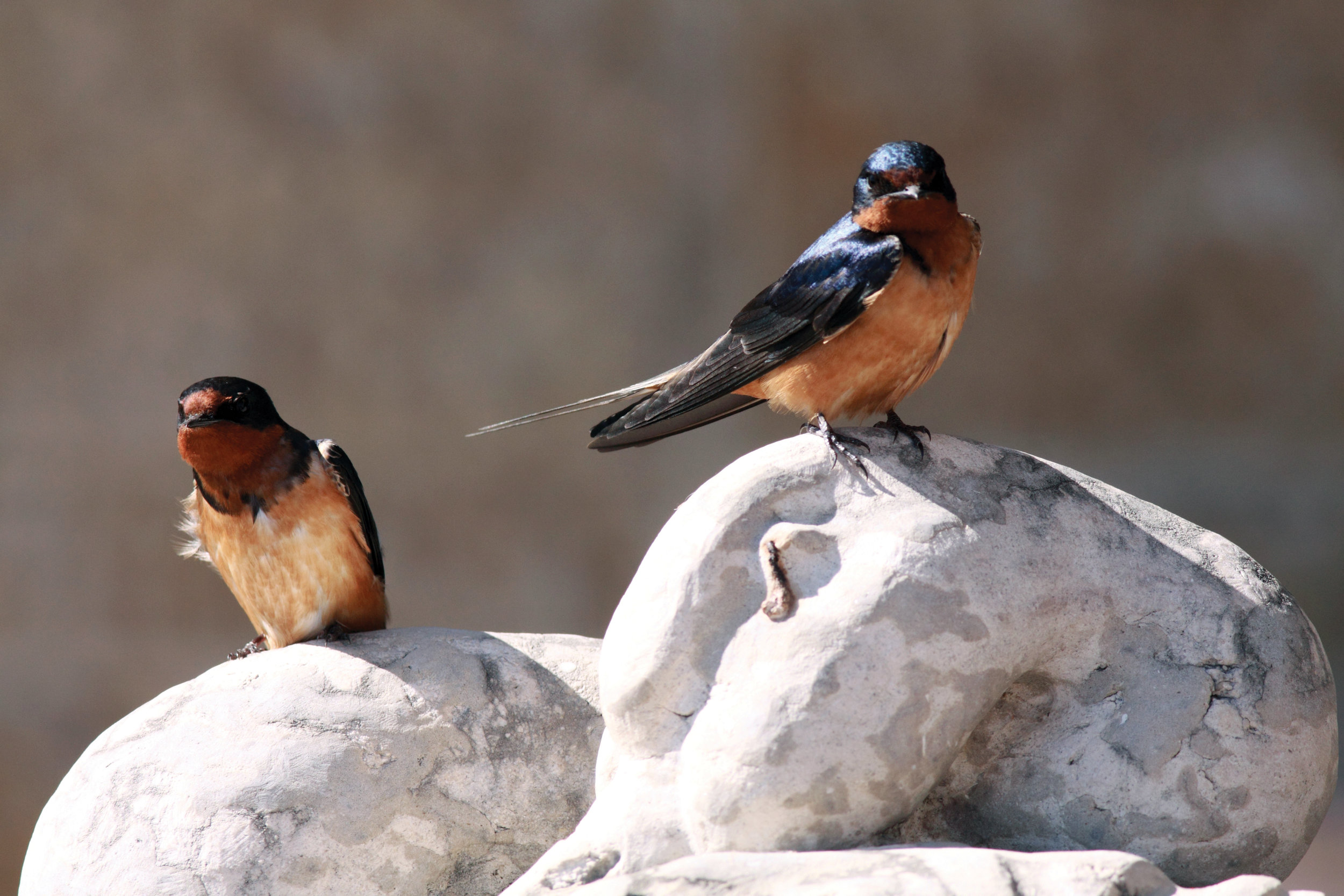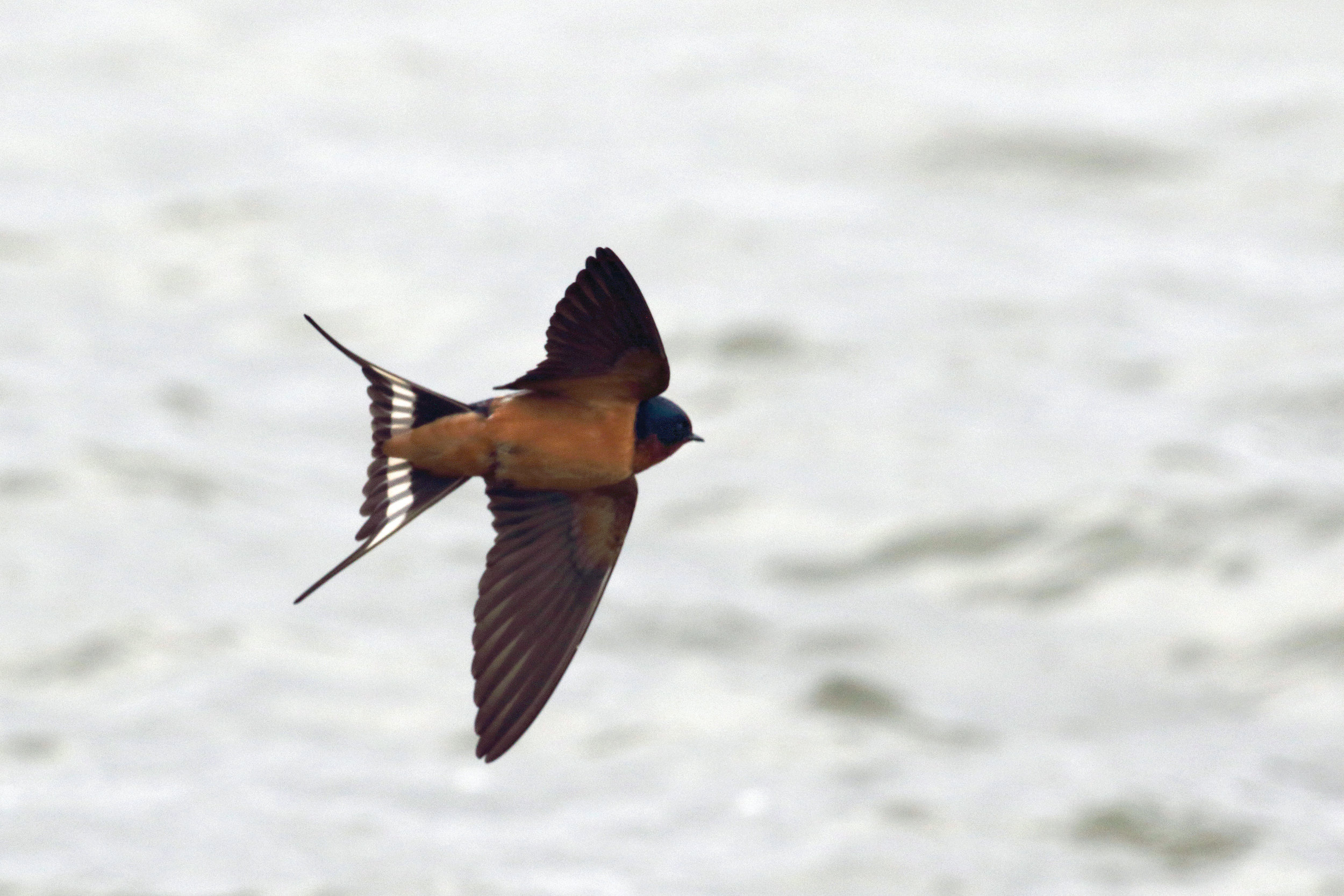Where are the swifts and swallows?
The plight of aerial insectivores in the Maritimes
by Amy-Lee Kouwenberg
Who among us remembers when chattering swallows used to swoop out from under bridges or glide over the fields of our childhood haunts? It seems these memories are becoming rarer, given that aerial insectivores (swifts, swallows, nightjars), a group of birds specializing in a diet of flying insects, are declining more than any other bird group in Canada. Over the last 40 years, three previously widespread species – Barn swallow, Tree swallow, and Chimney swift – have experienced population declines of 76 percent, 62 percent, and 95 percent, respectively. Similarly drastic trends have been documented in Atlantic Canada.
The reasons for these declines are not fully understood, but may include: decreasing availability of flying insects due to agricultural intensification, pesticide use, and climate change; habitat loss; and human persecution due to concerns for health and safety (e.g., nests in chimneys, bird droppings, and perceived spread of pathogens).
A common factor for Chimney swifts and various species of swallow is that much of their nesting habitat is on private land. Unlike many other species at risk that might be rare and difficult to find, swallows and swifts can literally be found in our own backyards – and buildings. This means landowners and communities can play an active role in conservation and recovery of these species. To this end, Bird Studies Canada launched a new program in 2015, providing information about swallows and swifts to the general public. The idea is that learning more about these interesting little insect-eating birds will remind people of the benefits of hosting them.
For example, did you know that a single swallow can eat as many as 850 insects per day? Imagine the improvement to those warm, mosquito-ridden summer evenings if you had a backyard swallow colony! The program is also designed to support landowners in becoming good stewards for aerial insectivores, and to encourage the public to help scientists monitor birds and their nests by reporting sightings through a special online portal.
SURVEY
Barns and agricultural areas are likely an important part of the conservation story for swifts and swallows. In the Maritimes, Bird Studies Canada piloted a survey which had two main goals: to collect information about Chimney swifts and swallows on private land, especially in barns and other structures used for nesting; and to gauge private landowners’ knowledge and attitudes toward this group of birds. We were particularly interested in finding Chimney swifts nesting in barns, a phenomenon that has been reported in southwestern Nova Scotia. In the summer of 2016 we extended our pilot survey to a larger number of landowners and properties across a wider geographic area. In total, we visited 155 properties (42 in 2015, and 113 in 2016) around Nova Scotia and southern New Brunswick.
Our questionnaires revealed that many landowners were unaware of the conservation issues relating to aerial insectivores, and unaware that Chimney swifts are listed as a species at risk. However, it was encouraging to find that the vast majority of landowners fostered a positive attitude toward swallows and swifts, and were enthusiastic about participating in their conservation.
While more than 80 percent of landowners reported having no concerns about swallows or swifts nesting on their properties, some were concerned that swifts could be a fire hazard in their chimney. In fact, nesting Chimney swifts do not pose a fire hazard. Only a single pair will occupy a chimney, building one tiny nest that is less than 10 cm (four inches) wide.
A few landowners were worried that swallow droppings might create a mess on their property, but these concerns are largely unfounded. Swallows create significantly less mess than other birds that use the same types of structures, such as starlings or sparrows. As well, swallow droppings are usually only noticeable under nests, so if a nest happens to be above a sensitive area, landowners can install a shelf under the nest to catch droppings, or simply cover the area with newspaper or other material. This type of approach allows landowners to minimize mess while also following the regulations set out by the Migratory Bird Convention Act, which state that it is illegal to disturb adults, nests, young, or eggs.
Despite dedicated searching by our property survey team, we found only one barn with a Chimney swift nest. However, these birds have tiny nests and are rarely heard or seen entering nest sites, so they are easy to miss. You may be able to help us find more Chimney swift nests in barns, so we can better describe whether this is a regular occurrence in the Maritimes.
In contrast to Chimney swift nests, active and inactive Barn swallow nests were found on many of the properties we surveyed. To better understand why some barns are occupied by swallows and others are not, we collected detailed data on the characteristics of the structures. Despite assessing a large variety of structure types (barns, sheds, garages, houses, etc.), uses (livestock, storage, etc.), and structural features (size, siding and roofing material, etc.), we found only one significant variable: Barn swallow nests were more likely to occur in structures with at least one access point (e.g. doors, windows, large holes).
In 2015-16, all landowners participating in the survey received an information package on aerial insectivores, detailing the challenges these birds face and some things we can do to make our property more hospitable to these species. In future, Bird Studies Canada would like to investigate other property features that could improve habitat for swifts and swallows. Given most landowners’ positive and receptive attitude, we feel that more can be done to support their stewardship efforts. We will continue our research on this front.
Until then, the take-home message from our 2015-16 surveys is this: rural landowners who wish to encourage swift and swallow nesting should keep barns open during the spring and summer. Also, we encourage people to continue searching for Barn swallow and Chimney swift nests in the peak or the darkest, highest corner of their barns, using a bright flashlight. Remember that these little birds can be elusive – you may never notice them until you spend time searching. Your sightings are important, and will help us to better understand these bird populations. Anything we can do to encourage nesting is a step toward conservation. Together, we can help ensure that these aerial acrobats continue to chatter and glide over the heads of our children and grand-children. For more information, or to report sightings, follow the “Swifts and Swallows” link at RuralLife.ca.
(Amy-Lee Kouwenberg is the coordinator for Bird Studies Canada’s Maritimes SwiftWatch Program, based in Sackville, N.B.)

























